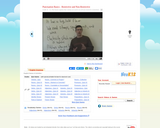
A TED Ed animated video on the correct use of semicolons.
- Subject:
- English Language Arts
- Material Type:
- Lesson
- Provider:
- TED
- Author:
- Emma Bryce
- Date Added:
- 02/26/2019

A TED Ed animated video on the correct use of semicolons.

This lesson reviews the sentence types, then has students write sentences of a variety of structures in a paragraph and review what they write.

An interactive, grade-specific spelling bee.

Students begin by evaluating the universal theme of betrayal from multiple perspectives. After reading time period scenarios as well as reflecting on personal experiences, students use critical thinking skills to explore and identify interventions for each betrayal scenario, including personal examples. Students then research Roman history as they write down thier own critical perspective of a scenario depicting plausible scenes from Roman times. As the culminating project and assessment, students will create comic strips with the Interactive Comic Creator

This literacy assessment includes an excerpt from "Julius Caesar," eight text-dependent questions, one constructed response writing prompt, and explanatory information for teachers regarding alignment to the CCSS.

Students discuss and examine the differences between electronic communication such as texts and emails versus more "traditional" means of writing. There is also a discussion on audience and puropse when writing, and students will practice writing a "style guide" page in order to reinforce conventions of standard English.

Students will read sentences that contain misused transition words and will write better transition words to complete the sentences. This resource supports English language development for English language learners.

This lesson plan is designed to guide students through a reading of the classic short story, "The Lady or the Tiger?". The lesson provides a guide for an in depth analysis of the text by asking students to seek textual evidence to respond to the provided guided questions. A culminating activity is provided, which directs learners to draft an essay that builds upon that textual evidence to draft a response posed by the title's question.

In this lesson, students learn the details about when and how to use semicolons, then practice the skills on sentence strips.

This lesson pairs a magazine article about the Edmund Fitzgerald shipwreck in 1975 with the Gordon Lightfoot song, "The Wreck of the Edmund Fitzgerald." After comparing and contrasting the elements of each text, students will choose a historical event and, using the song as a model, create a narrative poem about their chosen event. In addition, more contemporary songs and current events will also work for this activity.

In the TED Ed lesson focused on language, students will explore spelling, meaning, and the complex history behind the structure of words. Discussion questions and additional resources are linked in the sidebar.

In this second part of a two-lesson Mid-Unit Assessment, students will review a classmates's written response using a Text Analysis Rubric. Afterward, students will review their own evaluation and use this info to revise their writing.

This video elaborates on the use of punctuation with restrictive and non-restrictive elements of sentences.

In this lesson, students will summarize information found in the Alabama Driver Manual and share their findings in a multimedia presentation. Students will be responsible for self-scoring and peer scoring the multimedia presentations.

This video demonstrates the usage of commas to set off participial phrases in sentences.

This lesson is designed to assist students with improving their use of punctuation to include: commas, semicolons, colons, and exclamation points. The lesson is designed to encourage students to focus on emotions and their connections with given forms of punctuation. By examining emotions, students gain the ability to better understand the different uses of various punctuation marks. The lesson includes multiple student handouts and examples. There are also pertinent extension activities attached.

In this lesson, students work in groups to become masters of specific elements of proofreading and revision. Then, groups are reformed so that each group contains one of each expert, allowing the new groups to revise each others' essays one element at a time.

In this lesson, students will learn how to punctuate dialogue in a narrative in order to accurately convey their meaning.

This video discusses the use of commas in restrictive and non-restrictive uses.

A series of grade-level worksheets on the correct use of punctuation marks.